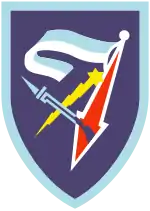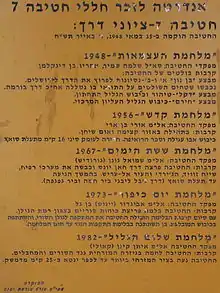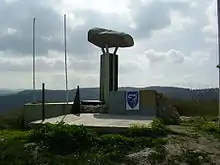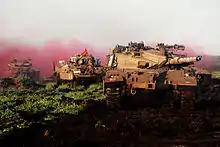7th Armored Brigade (Israel)
The 7th Armored Brigade (Hebrew: חטיבה שבע, Hativa Sheva) is a military formation of the Israel Defense Forces (IDF). Formed during the 1948 Arab–Israeli War and in operation ever since, it is the oldest armored brigade in the IDF.[1] The brigade took part in all of Israel's wars. During the Battles of Latrun in 1948, the 3rd Alexandroni and 7th Brigades together suffered 139 casualties. It fought in the Six-Day War under the command of Colonel Shmuel Gonen (Gorodish). In the Yom Kippur War, under the command of Colonel Avigdor Ben-Gal, it was stationed at the defense line of the northern part of the Golan Heights (sharing the defense with the Barak Armored Brigade), where it successfully repulsed heavy attacks by much larger Syrian forces.
| Hativa Sheva Armor Brigade | |
|---|---|
 Insignia of the 7th Brigade | |
| Active | 1948–present |
| Country | |
| Branch | Army |
| Type | Armor |
| Part of | Northern Command |
| Garrison/HQ | Camp Saar |
| Engagements | |
| Commanders | |
| Notable commanders | Avigdor Kahalani, Shmuel Gonen |
During the 1948 War, the 7th Brigade primarily consisted of Sherman tanks and mounted infantry. Early on, the 7th also contained an artillery element. During the 1960s, the brigade was equipped with British Centurion tanks modified in Israel. These were gradually superseded in the late 1970s by the Israeli-made Merkava main battle tanks, of which several versions have since been employed.
The 7th Brigade once belonged to Israel's Southern Command. The 7th was based in the Golan Heights as part of the 36th Armored Division from the end of the Yom Kippur War until February 2014.[2] The Syrians were effectively decimated, although they had amassed thousands of Soviet-designed T-55 tanks, thousands of field artillery, and thousands of troops.
Reputation
In 1948, the brigade's reputation was as one of the crueler combat forces of the period.[3] Israeli historian Ilan Pappé writes: "In many of the Palestinian oral histories that have now come to the fore, few brigade names appear. However, Brigade Seven is mentioned again and again, together with such adjectives as 'terrorist' and 'barbarous.'"[3][4]



The 7th Brigade was initially equipped with jeeps and cars with a few machine guns in July 1948, when the experienced Canadian officer Ben Dunkelman took over. He sized up two approaching Egyptian battle groups equipped with half-tracks, US M4 Sherman tanks and other vehicles. Dunkelman attacked both of them by surprise at night, when the crews were out of their vehicles. The Egyptian soldiers fled, allowing the 7th Brigade to appropriate their arms and vehicles.[5]
Units
- 71st Battalion was in the 1948 Latrun Battles
- 72nd Battalion was in the 1948 Latrun Battles
- 73rd Battalion was in the 1948 Latrun Battles
- 75th "Romach"/"Lance" Armor Battalion (Merkava Mk.4M)
- 77th "Oz"/"Courage" Armor Battalion (Merkava Mk.4M)
- 79th Battalion was in the 1948 Operation Hiram
- 82nd "Gaash"/"Rage" Armor Battalion (Merkava Mk.4M)
- 603th "Lahav"/"Blade" Armored Engineer Battalion
- Palsar 7 – 356th Reconnaissance Company
- Palhik 7 – 353rd "Hanit/Spear" Communications Company
Brigade commanders
- Shlomo Shamir (May – July 1948)
- Ben Dunkelman (July 1948 – July 1949)
- Yosef Eitan (July 1949 – July 1950)
- Shmuel Goder (October 1950 – August 1953)
- Yitzhak Pundak (April 1954 – October 1955)
- Uri Ben-Ari (October 1955 – December 1956)
- Aharon Nachshon (December 1956 – March 1958)
- David Elazar (December 1958 – April 1959)
- Israel Tal (April 1959 – April 1960)
- Arye Shakhar (June 1960 – July 1961)
- Avraham Adan (July 1961 – January 1963)
- Herzl Shafir (January 1963 – December 1964)
- Shlomo Lahat (January 1965 – May 1966)
- Shmuel Gonen (June 1966 – June 1969)
- Ya'akov Even (June 1969 – June 1971)
- Gabriel Amir (June 1971 – September 1972)
- Avigdor Ben-Gal (September 1972 – February 1974)
- Ori Orr (February 1974 – December 1975)
- Avigdor Kahalani (December 1975 – October 1977)
- Yossi Ben-Hanan (October 1977 – June 1979)
- Nati Golan (June 1979 – March 1981)
- Eitan Kauli (Keinan) (March 1981 – September 1982)
- Meir Zamir (September 1982 – February 1984)
- Amir Noy (May 1984 – September 1985)
- Avraham Palant (September 1985 – May 1987)
- Efraim Laor (May 1987 – November 1988)
- Dubik Rosenthal (Tal) (November 1988 – July 1990)
- Zvika Gendelman (July 1990 – January 1992)
- Yitzhak Harel (January 1992 – October 1993)
- Gershon HaCohen (October 1993 – August 1995)
- Dan Biton (August 1995 – August 1997)
- Shmulik Rosenthal (August 1997 – April 1999)
- Ya'akov Ayash (April 1999 – July 2001)
- Halutzi Rudoy (July 2001 – August 2003)
- Eyal Zamir (August 2003 – September 2005)
- Amnon Eshel (Asulin) (September 2005 – August 2007)
- Ro'i Elkavetz (August 2007 – May 2009)
- Ya'akov Banjo (May 2009 – July 2011)
- Oded Basyuk (July 2011 – June 2013)
- Nadav Lotan (June 2013 – July 2015)
- Dan Noyman (July 2015 – August 2017)
- Roman Gofman (August 2017 –)
Source: [6]
References
| Wikimedia Commons has media related to 7th Armored Brigade (Israel). |
- Matan Galin (20 December 2012). "Improving with age: the 7th Armored innovates". Israeli Defense Forces (www.idf.il).
- Lappin, Yaakov (2014-02-23). "Amid raging conflict in Syria, IDF deploys new division to border - Defense - Jerusalem Post". Jpost.com. Retrieved 2016-04-14.
- Dan Freeman-maloy (Winter 2011). "Mahal and the Dispossession of the Palestinians". Journal of Palestine Studies. 40 (2). JSTOR 10.1525/jps.2011.XL.2.43.
- Ilan Pappé, The Ethnic Cleansing of Palestine (Oxford: Oneworld Publications, 2006). Page. 158
- Dunkelman, Ben (1984). Dual Allegiance: An Autobiography, Goodread Biography. ISBN 0-88780-127-7
- "7th Brigade Commanders". Archived from the original on July 10, 2011. Retrieved March 21, 2010.